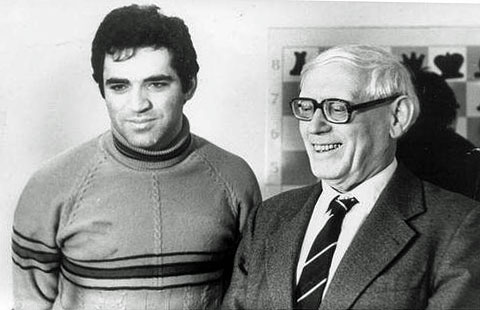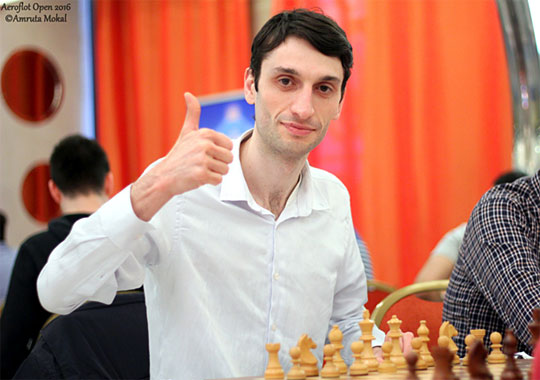Talking about the Queen's Gambit - an interview with Robert Ris
Dear Robert, you are an International Master, a commentator and an author. On one of your ChessBase DVDs you recommend to play the Exchange Variation against the Queen’s Gambit Declined. In round 4 of the Fide Grand Prix tournament in Sharjah, Shakriyar Mamedyarov followed your recommendation and won a spectacular game against Michael Adams.
What did you think when you saw that game?
Hi Johannes. I truly enjoyed that game as well, particularly since I recorded a DVD on the current topic and it's always nice when the quality of your published material is approved by the World's best players.
Mamedyarov won a good game but this was just one game. Are there more fundamental reasons to play this line for White?
The setup with Bd3, Nge2, 0-0 followed by the central break f3 and e4 was a new approach by Botvinnik in his time. Later other players refined his play and you see that even today it has been considered the most challenging way to deal with the move order 1.d4 d5 2.c4 e6 3.Nc3 Nf6. The fact that White's pieces are harmoniously working together, aiming to control the centre and build up an attack confirms the soundness of White's strategy.
Do you remember how you got interested in that line?
I think it was when I was around 15 years old, when I studied Kasparov's games. He followed this opening recipe from his mentor.

Garry Kasparov and Mihail Botvinnik
Back then I was a 1.e4 player but those games inspired me starting to experiment with 1.d4. Not much later when I totally switched `to 1.d4 I had to build a repertoire and started to work out the lines in more detail.
You are a specialist for sharp gambit play but most grandmasters of today seem to prefer a more solid approach in the opening – after all, it is no coincidence that the Berlin is so popular. Why do the top grandmasters play it safe and solid?
There is simply too much information available for everyone. In majority of the cases they play it safe with Black and try to push with White. Fortunately for top-chess there are also a lot fighting players who dare leaving their comfort zone and take a risk.
Gambits often seem to be a kind of gamble – you hope to surprise the opponent in the opening by playing moves that may be dangerous but are objectively harmless if the opponent knows the right answer.
Well some gambits will probably not return in grandmaster games, but some are still working out well as a surprise weapon indeed. For example, Adhiban's play in Wijk aan Zee was absolutely refreshing. With so much information accessible opening preparation the suprise value of your opening choice has perhaps overtaken the objective quality of the moves or opening systems. Most of my students are struggling with this question, but I would recommend them to be confident about their opening systems as long as they have an idea of what they are doing!
You seem to like to play and research surprising, double-edged openings. Where do you get your inspirations for such openings?
Perhaps I shouldn't reveal too much of my own playing style, but anyway I'm not playing too much these days. But I have always liked to use a scientific approach to study chess openings, realizing it's perhaps not the most efficient way of improving as a player, but I simply like it too much. Hence, I have analysed the most obscure opening lines, but seldomly used them in practice. It's a personal issue that I don't have the courage to play such lines when I know it's too risky or simply incorrect. So, I better keep using this opening material for the Fast & Furious shows on PlayChess!
Can the average player today, in the time of heavy computer analysis, still find new ideas in the openings – or do you have to be an International Master or Grandmaster to do so? And if yes, how?
The good thing about being an average player is that, in my opinion, in most of the cases the game leaves theoretical paths earlier and original positions will be reached more often than in grandmasters games. And yes, when it comes down to preparation with engines I think the average player can discover new ideas too, why not? Both can follow the recommendations of the engine, but perhaps the main advantage of grandmasters they are better evaluating long-term play. So in tactical positions the average player shouldn't be any worse than a GM, but in positional type of play it may help the player to have a deeper understanding of the game.
Are there any players who you admire for their creative play in the opening?
Well, in general I like to see different type of players no matter the stage of the game. But when it comes down to creative opening play the names of Rapport, Mamedyarov and Jobava just spring to mind.

Baadur Jobava believes in creative opening play (Photo: Amruta Mokal)
Last question: what project are you currently working on?
Well my main project at the moment is not chess-related, as I just bought an apartment in Amstelveen, a city next to Amsterdam with 90.000 inhabitants, and I will move in there in next week! By the way, every year I organize in Amstelveen a chess week with different activities, including the Dutch Rapid Championships (http://cne-nkrapid.nl/). We are already preparing the event, which will take place in the last quarter of 2017. But besides that I do have my own Amsterdam Chess Academy as I'm involved in several chess promoting activities, teaching in primary schools, private clients and online training with students from all over the world. So, never a dull moment!
 |
Robert Ris
A World Champions Repertoire against
the Queen's Gambit Declined
• Video running time: 5 hours (English)
• With interactive training including video feedback
• Exclusive database with with 50 essential games
• Including CB 12 – Reader
€29.90
€25.13 without VAT (for Customers outside the EU)
$27.14 (without VAT)
This DVD can be purchased as a hard copy or it can be downloaded directly from the Internet, that way sparing you the few days needed for it to arrive by post.
Order this Fritztrainer in the ChessBase Shop |


























